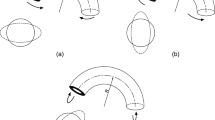Abstract
The aim of this work is to derive analytical solutions for the remaining capacity of perforated tubular structures, which are subjected to combined loading of bending and tensile or compressive stresses. Effects of internal pressure and loads of thermal origin are not considered. Parametric study addresses the increase in the cross section ultimate bending capacity when considering strain hardening effects compared to the assumption of elastic-perfectly plastic material. The need for operation extension for longer periods than initially foreseen, the possibility of relocation and reuse of these structures, for example, has motivated studies related to the structural integrity of these members and their subcomponents. It is sought to present formulations that help the decision-making to repair or replace deteriorated elements identified in inspections, in view of the economic impact coming from offshore works and, mainly, from possible production losses.










Similar content being viewed by others
Abbreviations
- \(\alpha\) :
-
Half-angle corresponding to the cross section remaining area
- \(\beta\) :
-
Ratio between yield and ultimate strengths
- \(\varepsilon\) :
-
Strain
- \(\gamma\) :
-
Hardening coefficient
- \(\psi\) :
-
Half-angle corresponding to the area subjected to tensile stress
- \(\sigma _{\text{max}}\) :
-
Ultimate strength
- \(\sigma _{\text{y}}\) :
-
Yield strength
- A :
-
Pipe cross section area
- \(A_{\text{c}}\) :
-
Area subjected to compressive stress
- \(A_{\text{t}}\) :
-
Area subjected to tensile stress
- E :
-
Young’s modulus
- e :
-
Eccentricity
- \(F_{\text{c}}\) :
-
Compressive force
- \(F_{\text{t}}\) :
-
Tensile force
- \(F_{\text{y}}\) :
-
Yield force
- M :
-
Bending moment
- \(M_{\text{c}}\) :
-
Compressive moment
- \(M_{\text{P}}\) :
-
Fully plastic moment
- \(M_{\text{t}}\) :
-
Tensile moment
- R :
-
Pipe cross section radius
- t :
-
Pipe cross section thickness
- \(y_{\text{c}}\) :
-
Distance between centroid of compressive area and centroid of whole pipe cross section
- \(y_{\text{t}}\) :
-
Distance between centroid of tensile area and centroid of whole pipe cross section
- \(Z_{\text{P}}\) :
-
Plastic section modulus
References
W. Chen, I. Sohal, Cylindrical members in offshore structures. Thin-Walled Struct. 6(3), 153–285 (1988)
M. Mohareb, D. Murray, Mobilization of fully plastic moment capacity for pressurized pipes. J. Offshore Mech. Arct. Eng. 121(4), 237–241 (1999)
N. Veritas, Rules for submarine pipelines (Det Norske Veritas, Oslo, 1996)
S. Hauch, Y. Bai, Bending moment capacity of pipes. J. Offshore Mech. Arct. Eng. 122(4), 243–252 (2000)
Y. Chen, J. Zhang, H. Zhang, X. Li, J. Zhou, J. Cao, Ultimate bending capacity of strain hardening steel pipes. China Ocean Eng. 30(2), 231–241 (2016)
A. Gresnigt, R.V. Foeken, Local buckling of UOE and seamless steel pipes, in The Eleventh International Offshore and Polar Engineering Conference, International Society of Offshore and Polar Engineers, Norway (2001). https://www.onepetro.org/conferencepaper/ISOPE-I-01-143
I. Ozkan, M. Mohareb, Moment resistance of steel pipes subjected to combined loads. Int. J. Press. Vessels Pip. 86(4), 252–264 (2009)
M. Mohareb, G. Kulak, A. Elwi, D. Murray, Testing and analysis of steel pipe segments. J. Ttransp. Eng. 127(5), 408–417 (2001)
H. Wang, X. Li, J. Zhou, Ultimate bending capacities of steel pipelines under combined loadings. Adv. Struct. Eng. 19(4), 642–659 (2016)
H. Okada, K. Masaoka, Y. Murotsu, I. Jusoh, A simplified method for estimating deterioration of collapse strength of damaged jacket structures, in Proceedings of the International Conference on Offshore Mechanics and Arctic Engineering, vol. 2 (American Society of Mechanical Engineers, 2001), pp. 359–366
H. Okada, K. Masaoka, S. Katsura, T. Matsui, A study on deterioration of strength and reliability of aged jacket structures. In: Ocean. 04. MTTS/IEEE Techno-Ocean 04, IEEE, vol 1, pp 186–192 (2004)
Y. Abdel-Nasser, K. Masaoka, H. Okada, Ultimate strength of dented tubular members subjected to compression and bending. Alex. Eng. J. 45(1), 37–46 (2006)
L. Lutes, T. Kohutek, B. Ellison, K. Konen, Assessing the compressive strength of corroded tubular members. Appl. Ocean Res. 23, 263–268 (2001)
Y. Chen, L. Xin, Y. Chai, J. Zhou, Assessment of the flexural capacity of corroded steel pipes. Int. J. Press. Vessels Pip. 87(2), 100–110 (2010)
S. Cho, J. Kwon, D. Kwak, Structural characteristics of damaged offshore tubular members. J. Ocean Eng. Technol. 24(4), 1–7 (2010)
T. Yao, J. Taby, T. Moan, Ultimate strength and post-ultimate strength behavior of damaged tubular members in offshore structures. J. Offshore Mech. Arct. Eng. 110(3), 254–262 (1988)
I. Fontes, Capacidade compressiva remanescente de elementos tubulares esbeltos com corroso externa. Master’s thesis, UFRJ (2014)
Y. Ueda, S. Rashed, Behavior of damaged tubular structural members. J. Energy Resour. Technol. 107(3), 342–349 (1985)
M. Jirasekand, Z. Bazant, Inelastic analysis of structures (Wiley, Hoboken, 2002)
Y. Bai, Q. Bai, Subsea pipelines and risers (Elsevier, Amsterdam, 2005)
Acknowledgements
The authors would like to thank the Human Resources Program of the National Petroleum, Natural Gas and Biofuels Agency (ANP), in particular PRH-03, and the National Council for Scientific and Technological Development (CNPq) for their support in the development of this research and financial support. The funding was received by Petrobras.
Author information
Authors and Affiliations
Corresponding author
Rights and permissions
About this article
Cite this article
Knupp, A.B., Vaz, M.A. & Cyrino, J.C.R. Ultimate bending capacity of perforated pipe cross sections. Mar Syst Ocean Technol 14, 34–41 (2019). https://doi.org/10.1007/s40868-018-00052-x
Received:
Accepted:
Published:
Issue Date:
DOI: https://doi.org/10.1007/s40868-018-00052-x



